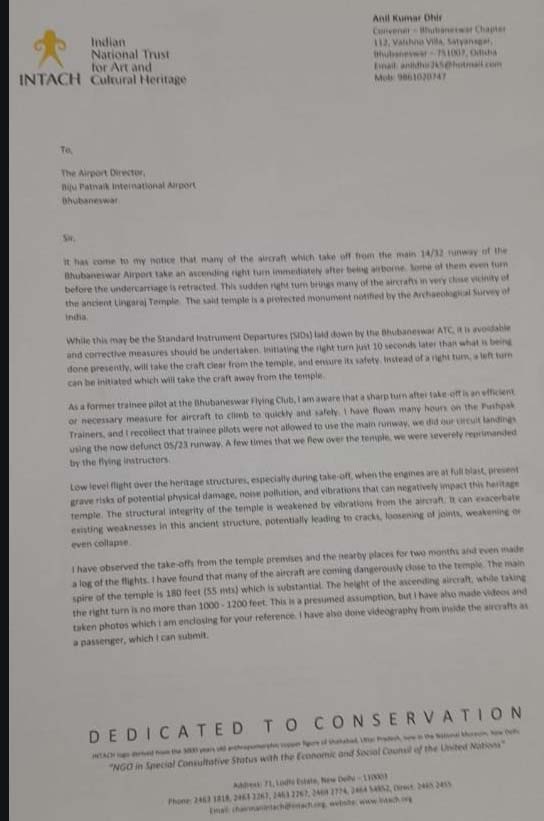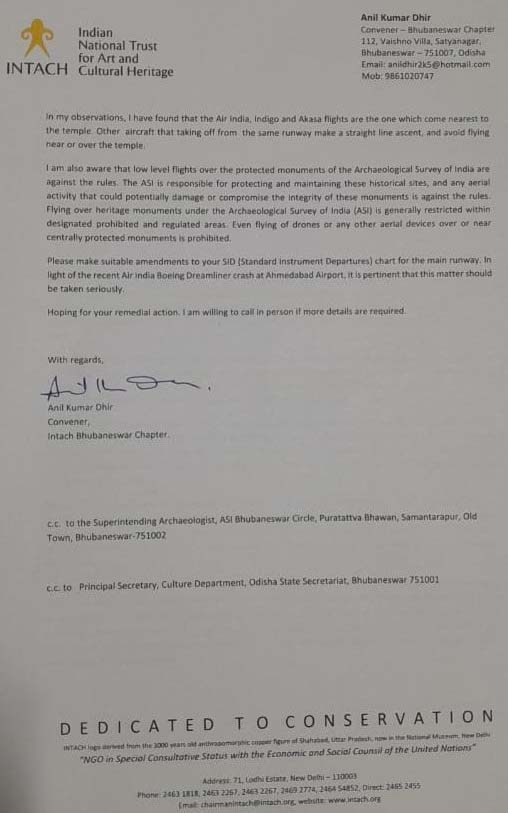Bhubaneswar 19th June : The Indian National Trust for Art and Cultural Heritage (INTACH) has voiced its concerns on the low level flights taking off from the main runway of the BPIA Airport. In letters written to the Airport Director of the Biju Patnaik International Airport, the Superintendent Archaeologist of the Archaeological Survey of India’s Bhubaneswar Circle and the Culture Secretary, Anil Dhir, the Convener of the Bhubaneswar Chapter has given in details the observations of a two month study conducted by him in the Old Town of Bhubaneswar.


In his letter, Dhir has pointed out that many of the aircraft which take off from the main 14/32 runway of the Bhubaneswar Airport take an ascending right turn immediately after being airborne. Some of them even turn before the undercarriage is retracted. This sudden right turn brings many of the aircrafts in very close vicinity of the ancient Lingaraj Temple. Many of the aircraft are coming dangerously close to the temple. The main spire of the temple is 180 feet (55 mts) which is substantial. The height of the ascending aircraft, while taking the right turn is no more than 1000 – 1200 feet.

Dhir, a former trainee pilot, says that even though this is the Standard Instrument Departure (SID) laid down by the Bhubaneswar ATC, it is avoidable and corrective measures should be undertaken. Initiating the right turn just 10 seconds later than what is being done presently, will take the craft clear from the temple, and ensure its safety.
Low level flight over the heritage structures, especially during take-off, when the engines are at full blast, present grave risks of potential physical damage, noise pollution, and vibrations that can negatively impact the temple. The structural integrity of the temple, which is already in a precarious state, will be further weakened by vibrations from the aircraft. These low level flights will exacerbate the existing weaknesses in this ancient structure, potentially leading to cracks, loosening of joints, weakening or even collapse.

Dhir has also given photos and videos, including videography done from inside the aircrafts as a passenger. He has stated that the Air India, Indigo and Akasa flights are the one which come nearest to the temple. Other aircraft that taking off from the same runway make a straight line ascent, and avoid flying near or over the temple.
Flying over heritage monuments protected by the Archaeological Survey of India (ASI) is generally restricted within designated prohibited and regulated areas. Even flying of drones or any other aerial devices over or near centrally protected monuments is prohibited. The ASI is responsible for protecting and maintaining these historical sites, and any aerial activity that could potentially damage or compromise the integrity of these monuments is against the rules. In light of the recent Air India Boeing Dreamliner crash at Ahmedabad Airport, it is pertinent that this matter should be taken seriously.
Dhir has appealed to the Airport authorities to make suitable amendments to the existing SID (Standard Instrument Departures) chart for the main runway.

To,
The Airport Director,
Biju Patnaik International Airport
Bhubaneswar.
Sir,
It has come to my notice that many of the aircraft which take off from the main 14/32 runway of the Bhubaneswar Airport take an ascending right turn immediately after being airborne. Some of them even turn before the undercarriage is retracted. This sudden right turn brings many of the aircrafts in very close vicinity of the ancient Lingaraj Temple. The said temple is a protected monument notified by the Archaeological Survey of India.
While this may be the Standard Instrument Departures (SIDs) laid down by the Bhubaneswar ATC, it is avoidable and corrective measures should be undertaken. Initiating the right turn just 10 seconds later than what is being done presently, will take the craft clear from the temple, and ensure its safety. Instead of a right turn, a left turn can be initiated which will take the craft away from the temple.
As a former trainee pilot at the Bhubaneswar Flying Club, I am aware that a sharp turn after take-off is an efficient or necessary measure for aircraft to climb to quickly and safely. I have flown many hours on the Pushpak Trainers, and I recollect that trainee pilots were not allowed to use the main runway, we did our circuit landings using the now defunct 05/23 runway. A few times that we flew over the temple, we were severely reprimanded by the flying instructors.
Low level flight over the heritage structures, especially during take-off, when the engines are at full blast, present grave risks of potential physical damage, noise pollution, and vibrations that can negatively impact this heritage temple. The structural integrity of the temple is weakened by vibrations from the aircraft. It can exacerbate existing weaknesses in this ancient structure, potentially leading to cracks, loosening of joints, weakening or even collapse.
I have observed the take-offs from the temple premises and the nearby places for two months and even made a log of the flights. I have found that many of the aircraft are coming dangerously close to the temple. The main spire of the temple is 180 feet (55 mts) which is substantial. The height of the ascending aircraft, while taking the right turn is no more than 1000 – 1200 feet. This is a presumed assumption, but I have also made videos and taken photos which I am enclosing for your reference. I have also done videography from inside the aircrafts as a passenger, which I can submit.

In my observations, I have found that the Air India, Indigo and Akasa flights are the one which come nearest to the temple. Other aircraft that taking off from the same runway make a straight line ascent, and avoid flying near or over the temple.
I am also aware that low level flights over the protected monuments of the Archaeological Survey of India are against the rules. The ASI is responsible for protecting and maintaining these historical sites, and any aerial activity that could potentially damage or compromise the integrity of these monuments is against the rules. Flying over heritage monuments under the Archaeological Survey of India (ASI) is generally restricted within designated prohibited and regulated areas. Even flying of drones or any other aerial devices over or near centrally protected monuments is prohibited.
Please make suitable amendments to your SID (Standard Instrument Departures) chart for the main runway. In light of the recent Air India Boeing Dreamliner crash at Ahmedabad Airport, it is pertinent that this matter should be taken seriously.
Hoping for your remedial action. I am willing to call in person if more details are required.
With regards,
Anil Kumar Dhir, Convener, Intach Bhubaneswar Chapter.
c.c. to the Suptd. Archaeologist, ASI Bhubaneswar Circle
c.c. to Principal Secretary, Culture Department
